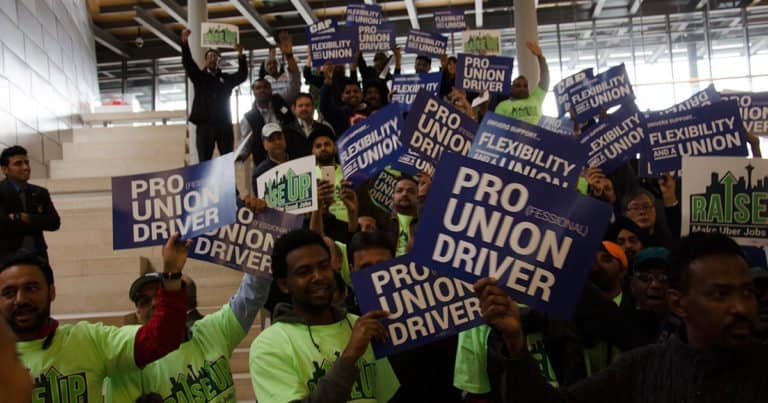
Sharon Block is a Professor of Practice and the Executive Director of the Center for Labor and a Just Economy at Harvard Law School.
The New York Times editorial last week celebrating the landslide victory of the ballot initiative to repeal Missouri’s right-to-work (for less) law was entitled, “The Wind at Labor’s Back.” Those words haven’t been put together in that order in a long time, as we have witnessed a decades-long decline in the size, power, and vitality of the U.S. labor movement. This pro-labor momentum, building from this spring’s teacher walkouts, raises many important questions about the future of the labor movement, including what labor law reforms would best build on and strengthen this momentum.
Last week brought several new answers to that question. Below are summaries of a new paper, book and blog post by prominent labor policy voices on the topic of labor law reform. These pieces all put forth bold agendas for reform; bolder and more comprehensive than any legislative proposals introduced in recent years. As I lamented last Labor Day, Congress’s previous effort to enact labor law reform, the Employee Free Choice Act, was far too weak to meet the peril of the moment. This year, Congressional Democrats introduced “the Better Deal,” a bolder approach to labor law reform but significantly less ambitious than the proposals outlined below. It will be interesting to see if these more ambitious proposals inspire Congress to rethink its more incrementalist approach when the opportunity arises to actually move legislation.
As Harvard’s Labor and Worklife Program begins our Clean Slate Project to reimagine American labor law as a means to rebalance our economic and political system, we welcome these contributions to the process of thinking big about reform. In addition, we are honored that all four authors whose work is discussed below are participants in the Clean Slate Project.
Rebuilding Worker Voice in Today’s Economy, by Kate Andrias and Brishen Rogers
The Roosevelt Institute published a paper by Kate Andrias, Professor of Law at the University of Michigan and Brishen Rogers, Associate Professor of Law at Temple University and a Visiting Fellow at the Roosevelt Institute, that articulates four key principles for fundamental labor law reform and a menu of policy options to advance those principles. Andrias and Rogers’ principles are that reform should: (1) protect all workers, in all segments of the economy; (2) make it far easier for workers to obtain workplace representation; (3) provide for sectoral-level bargaining; and (4) better protect workers’ rights to strike, picket, and engage in other concerted action. Reading the Andrias-Rogers paper is like taking a master class in labor law reform. They present the most serious ideas without advocating for specific policies but with sufficient context and analysis for readers to form their own opinions as to the best path forward.
Taken together, Andrias and Rogers’ policy options would construct a labor law in which many more workers have many more options for how to act collectively and more control over who is sitting on the other side of the bargaining table. Most fundamentally, they believe that sectoral bargaining—either through European-style contract extensions or industry-wide labor standard setting mechanisms—should be an option available to workers to supplement, not replace, enterprise-based worker representation. In addition, they continue to contemplate existing labor unions as the principle institutions of worker representation.
Instead of abandoning the basics of the current model, Andrias and Rogers propose many different options for optimizing that system, including some truly bold ideas. For example, they would repeal many of the statutory exceptions to the NLRA’s coverage and loosen standards for employee status and joint employment to greatly expand the collective-bargaining franchise. They propose consideration of a range of ways of making the process of choosing representation easier, from eliminating election delays to regularly scheduling elections to making union representation the default. Andrias and Rogers call for consideration of measures that would give workers the choice to broaden the scope of bargaining to a multi-employer basis. They also recommend consideration of giving workers the choice of bargaining on a narrower basis by choosing minority unions or works councils. Finally, they offer a suite of NLRA amendments to strengthen the right to strike and picket, such as banning striker replacements and repealing the prohibition on secondary boycotts.
A Roadmap to Rebuilding Worker Power, by David Rolf
It will come as no surprise to regular readers of OnLabor that David Rolf’s vision of the next generation of worker organizations, as spelled out in his new book published by The Century Foundation, abandons almost all attributes of the current system. Rolf is a long-time labor leader, soon ending his tenure as President of SEIU Local 775, who shortly after the 2016 election declared the traditional labor movement dead in a guest post for OnLabor. In its place, he envisions a “nimble, adaptive ecosystem” of new worker organizations that can fulfill his three tenets of success: power, scale, and sustainable revenue.
Rolf offers nine “value propositions” or strategies that he believes worker organizations could adopt to achieve success:
- advocacy;
- benefits provision and administration;
- regional and sectoral bargaining;
- codetermination;
- worker training and supply;
- job placement and matching;
- labor standards enforcement;
- certification and labeling; and
- worker ownership.
Much of the book is an analysis of how effectively each of these strategies would be in achieving power, scale and sustainability. Rolf draws on examples from history, other countries, and other analogous social movement organizations.
Many of Rolf’s recommendations do not need labor law reform for adoption. Instead, he calls for labor leaders to adopt a spirit of entrepreneurship in building these new types of organizations. His book does, however, make several calls for labor law reform in order to catalyze formation of new worker organizations consistent with his value propositions. Specifically, he recommends: adoption of wage boards at the state and local level; expansion of mandated worker training; adoption of co-enforcement strategies by labor standards enforcement agencies; procurement and licensing standards that require higher labor standards; incentives for worker ownership; and creation of a portable benefits system. Finally, he endorses the adoption at the federal level of a reimagined labor law to replace the NLRA’s enterprise-based bargaining system.
Building the Institutions Needed to Strengthen Worker Voice, by Tom Kochan
In a blog post for the Aspen Institute’s Reconnecting Work and Wealth initiative, Tom Kochan, the George M. Bunker Professor at MIT’s Sloan School of Management, presents compelling evidence of what he calls the “worker voice gap.” Kochan led a national survey of American workers on their satisfaction with their voice on the job. His survey found that “[a] majority of American workers report having less of a voice at work than they believe they should have on benefits, wages, promotions, job security, respect, and training. And more than a third to half of respondents report experiencing a voice gap on other workplace issues.” The results of his survey led Kochan to call for “a fundamental change in labor law” in his blog post.










Daily News & Commentary
Start your day with our roundup of the latest labor developments. See all
December 22
Worker-friendly legislation enacted in New York; UW Professor wins free speech case; Trucking company ordered to pay $23 million to Teamsters.
December 21
Argentine unions march against labor law reform; WNBA players vote to authorize a strike; and the NLRB prepares to clear its backlog.
December 19
Labor law professors file an amici curiae and the NLRB regains quorum.
December 18
New Jersey adopts disparate impact rules; Teamsters oppose railroad merger; court pauses more shutdown layoffs.
December 17
The TSA suspends a labor union representing 47,000 officers for a second time; the Trump administration seeks to recruit over 1,000 artificial intelligence experts to the federal workforce; and the New York Times reports on the tumultuous changes that U.S. labor relations has seen over the past year.
December 16
Second Circuit affirms dismissal of former collegiate athletes’ antitrust suit; UPS will invest $120 million in truck-unloading robots; Sharon Block argues there are reasons for optimism about labor’s future.